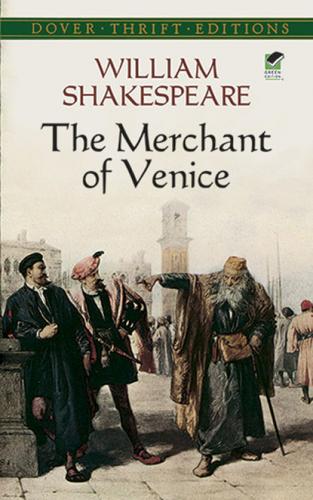At Dover Publications we’re committed to producing books in an earth-friendly manner and to helping our customers make greener choices.
Manufacturing books in the United States ensures compliance with strict environmental laws and eliminates the need for international freight shipping, a major contributor to global air pollution. And printing on recycled paper helps minimize our consumption of trees, water and fossil fuels.
The text of this book was printed on paper made with 10% post-consumer waste and the cover was printed on paper made with 10% post-consumer waste. At Dover, we use Environmental Defense’s Paper Calculator to measure the benefits of these choices, including: the number of trees saved, gallons of water conserved, as well as air emissions and solid waste eliminated.
Please visit the product page for The Merchant of Venice at
www.doverpublications.com to see a detailed account of the environmental savings we’ve achieved over the life of this book.
DOVER THRIFT EDITIONS
GENERAL EDITOR: STANLEY APPELBAUM
EDITOR OF THIS VOLUME: CANDACE WARD
Performance
This Dover Thrift Edition may be used in its entirety, in adaptation or in any other way for theatrical productions, professional and amateur, in the United States, without fee, permission or acknowledgment. (This may not apply outside of the United States, as copyright conditions may vary.)
Bibliographical Note
This Dover edition, first published in 1995, contains the unabridged text of The Merchant of Venice as published in Volume II of The Caxton Edition of the Complete Works of William Shakespeare, Caxton Publishing Company, London, n.d. The Note and explanatory footnotes were prepared specially for this edition.
Copyright
Copyright © 1995 by Dover Publications, Inc. All rights reserved.
Library of Congress Cataloging-in-Publication Data
Shakespeare, William, 1564—1616.
The merchant of Venice / William Shakespeare.
p. cm. — (Dover thrift editions)
Text taken from The Caxton edition of the complete works of William Shakespeare, v. 2.
9780486113814
1. Jews—Italy—Venice—Drama. I. Title. II. Series.
PR2825.A1 1995
822.3’3—dc20 95-10121
CIP
Manufactured in the United States by Courier Corporation
28492113
NOTE
The Merchant of Venice was probably written about 1596. Though a comedy, the play includes tragic elements and is wrought with dramatic tension. The primary plot revolves around two pairs of lovers, Portia and Bassanio, and Jessica and Lorenzo. But it is the relationship between Antonio, the merchant of Venice, and the moneylender Shylock that unites the play and provides the central conflict. Briefly, Antonio has borrowed money from Shylock in order to help Bassanio court Portia; the terms of the bond are such that if he cannot repay the loan within three months, he must give Shylock a pound of his flesh.
The unsympathetic portrayal of the Jewish moneylender is a troubling element in Shakespeare’s play and it is often read as a reflection of attitudes in England at the end of the sixteenth century. One contemporary incident that might have influenced Shakespeare’s characterization of Shylock involved Queen Elizabeth’s personal physician, the Portuguese Jew Roderigo López. López was appointed interpreter and guardian of Antonio Pérez, an exile from Philip II’s Spanish court. After becoming involved in a series of court intrigues, including an unsuccessful plot to assassinate Pérez, López was implicated in an attempt to poison the Queen. Although the Queen herself was unconvinced of his guilt, under pressure from the earl of Essex she signed López’s death warrant. He was publicly executed (hanged, drawn and quartered) on June 7, 1594. The jeering crowd that witnessed the execution, the popularity of Shakespeare’s play and the successful revival of Marlowe’s The Jew of Malta reveal the extent of anti-Jewish sentiment at the time.
If Elizabethan audiences were unsympathetic toward Shylock, succeeding ones were drawn to him. Writing in the early nineteenth century, William Hazlitt saw “a strong, quick, and deep sense of justice mixed up with the gall and bitterness of [Shylock’s] resentment.... [W]e pity him, and think him hardly dealt with by his judges.” Bernhard Ten Brink allowed that Shylock’s punishment for the most part is “nothing more than poetic justice.” But, he adds, upon Antonio’s stipulation that Shylock convert to Christianity, “our feelings justly rebel.... Shylock has come too close to us, we have learned to know too intimately the grounds of his hatred, of the intensity of his resentment, his figure has become too humanly significant and the misfortune which overtakes him appeals too deeply to our sympathies, to permit us to be reconciled to the idea that his fate, which moves us so tragically, should be conceived as otherwise than as a tragedy.”
Table of Contents
Title Page Copyright Page NOTE DRAMATIS PERSONÆ ACT I. ACT II. ACT III. ACT IV. ACTV.
DRAMATIS PERSONÆ
THE DUKE OF VENICE.
ANTONIO, a merchant of Venice.
BASSANIO, his friend, suitor likewise to Portia.
LORENZO, in love with Jessica.
SHYLOCK, a rich Jew.
TUBAL, a Jew, his friend.
LAUNCELOT GOBBO, the clown, servant to Shylock.
OLD GOBBO, father to Launcelot.
LEONARDO, servant to Bassanio.
PORTIA, a rich heiress.
NERISSA, her waiting-maid.
JESSICA, daughter to Shylock.
Magnificoes of Venice, Officers of the Court of Justice, Gaoler,
Servants to Portia, and other Attendants.
